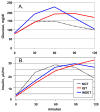Oral glucose tolerance testing in children with cystic fibrosis
- PMID: 20202149
- PMCID: PMC3856892
- DOI: 10.1111/j.1399-5448.2009.00632.x
Oral glucose tolerance testing in children with cystic fibrosis
Abstract
Background: Cystic fibrosis (CF) related diabetes is the most common comorbidity in persons with CF. International Society for Pediatric and Adolescent Diabetes (ISPAD) guidelines recommend annual oral glucose tolerance testing (OGTT) screening starting at age 10. The OGTT might be recommended in younger children if, as in adults, it provided clinically relevant prognostic information. A database review was performed to determine whether OGTT findings in children with CF predict subsequent clinical course.
Methods: A retrospective matched-pair cohort study was based on OGTTs performed during 1998-2003. Children aged 6-9 were classified as having normal glucose tolerance (NGT) or abnormal glucose tolerance (AGT). Children with AGT were matched by age and gender to those with NGT. Clinical status was assessed at baseline and 5 yr later. In a separate investigation, diabetes and prior AGT status of children aged 10-18 were used to assess predictions derived from the cohort study.
Results: In 1998-2003, 39 of 94 children had AGT. Of these, 31 had sufficient follow-up data to be included. Both at baseline and 5 yr later there was no significant difference in height, weight, body mass index (BMI) or lung function between AGT and NGT. Diabetes developed in 13 AGT (42%) and one NGT (3%) [odds ratio (OR) 11, p = 0.0009]. Age of diabetes onset was 12 ± 1 yr in boys and 11 ± 1 yr in girls, compared to approximately 23 yr in the general CF population. Fifteen current children age 10-18 who had AGT before age 10 have diabetes, close to the prediction of 19.
Conclusions: AGT in children with CF age 6-9 yr identifies those at high risk for progression to early onset diabetes.
© 2010 John Wiley & Sons A/S.
Figures
References
-
- Moran A. Updates on CFRD guidelines. Pediatric Pulmonology Suppl. 2009;32:208–209.
-
- O’Riordan SMP, Robinson PD, Donaghue KC, Moran A. ISPAD clinical practice consensus guidelines 2008: management of cystic fibrosis-related diabetes. Pediatric Diabetes. 2008;9:338–344. - PubMed
-
- Milla CE, Warwick WJ, Moran A. Trends in pulmonary function in cystic fibrosis patients correlate with the degree of glucose intolerance at baseline. Am J Resp Crit Care Med. 2001;162:891–895. - PubMed
Publication types
MeSH terms
Grants and funding
LinkOut - more resources
Full Text Sources
Other Literature Sources
Medical
Miscellaneous


